Extension tubes are really handy. Because they have no glass elements, they aren’t very heavy, and you can couple two or three together and put them into one pouch, and they are no bigger than a small lens, so they fit in the photographer’s vest without taking up much room.
When you put an extension tube between the lens and the camera, your focus distance decreases, so you can focus on things closer than you would be able to without the tube. The caveat is that they also reduce the maximum focus distance, so once fitted, you can no longer focus on infinity. The wider the lens, the more drastic the change in focus distance. With wide angle lenses, you almost touch your subject before you get it in focus. It can give you some fun effects, but not that practical. Tubes work best with 50 to 100mm lenses, or even with very long lenses that usually have very long minimum focus distances, to allow you to shoot small birds quite large in the frame. Many people use extension tubes for macro or close-up photography, to get larger than life-size, or 1:1 magnification.
Having just bought a second 25mm extension tube (Canon Extension Tube EF 25 II), to give me 50mm, or 62mm with the 12mm extension tube also fitted, and also after receiving a question on my Canon EF 100mm F2.8 L Hybrid IS Macro lens review blog post, I figured I’d do a few tests to see how the combined extension tubes and a Canon 1.4X Extender effect the magnification of the lens.
The 5D Mark II sensor dimensions are 24x36mm, the same size as a 35mm film frame. This means that when shooting at life-size, something that is 36mm wide would be 36mm on the sensor.
For my tests I cranked the focus back as far as it would go, and focused with focusing rails, to get as close as possible. The first thing I noticed as I framed the first test image is that the 100mm F2.8L IS MACRO lens actually focuses slightly larger than 1:1, or life-size, as the resulting image included just 34.5mm of a steel rule. This means that right off the bat, we are actually shooting at 1.04:1, but to show the effect of the extension tubes and 1.4X Extender, I’m going to use 1:1 as the base.
Here are the images, straight out of the camera, with no cropping or rotation or anything (though re-sized for Web of course).
First, just the straight 100mm F2.8 L IS MACRO lens, with nothing attached, giving us a slightly larger but as good as life-size image:
This is with one Canon 25mm extension tube attached. This results in 1.35:1 magnification (below):
This is with two Canon 25mm extension tubes attached, giving us 50mm of extension. This results in 1.73:1 magnification (below):
Next I added the Canon 12mm extension tube to the two 25mm tubes, giving us 62mm of extension. This results in 1.9:1 magnification (below):
Finally, I tried the Canon 1.4X Extender II. This gave me a 2.71:1 magnification (below):
Note that the Extender doesn’t effect the minimum focus distant as tubes do, so for this last shot I didn’t have to crank the focusing rails, like in the other shots, though I did fine tune the focus.
Here’s a table of the results, for quick comparison.
| Lens and Modifier | Width on Sensor |
Magnification |
| 100mm Macro without any tubes etc. | 34.5mm | 1:1 |
| With 25mm extension tube | 25.5mm | 1.35:1 |
| 50mm (2x25mm extension tubes) | 20mm | 1.73:1 |
| 62mm (2x25mm + 12mm tubes) | 18.2mm | 1.9:1 |
| 62mm Ext Tubes + 1.4X Extender | 12.75mm | 2.71:1 |
Conclusions
Well, on the magnification front, you can get down to 1.9 and 2.7X magnification pretty easily, with stuff that you may well have with you anyway. I own the Canon Canon MP-E 65mm F2.8 1-5x Macro lens as well, but I don’t always take it out, unless I know I’m going to specifically shoot macro. Also, although I haven’t yet tested this, I’m sure the Hybrid IS works to a degree, even when shooting larger than life-size, so that is another advantage over the 65mm.
The whole setup does get pretty long with 62mm of tubes and the 1.4X Extender, which can be good for getting close to your subject, but also makes it a little more difficult to balance than the MP-E 65mm macro lens. One other benefit of the 100mm with tubes, is that you have some focusing leeway. With the MP-E 65, you have no focus mechanism as such, although you can increase or decrease magnification which does move the focus. Basically though, you have to use a focusing rail and move whole setup (camera and lens) back and forth to focus.
I didn’t use a controlled constant light-source, just shooting with ambient light in my kitchen, but one thing to note is that for each 25mm tube, I had to increase the exposure by 2/3 of a stop. The 12mm tube needed 1/3 of a stop, and the 1.4X magnifier required an extra stop of light to create images of the same exposure.
One other thing to note is that I was impressed with the image quality right through the range. The whole series are pretty impressively sharp, to say that I’m sticking a lot of distant and even glass with the 1.4X Extender, between the 100mm Macro lens and the camera.
I’m not sure that I’ll use all of these tubes and the 1.4X Extender in the field, but it’s good to know that it’s there as an option.
B&H carry stock of the equipment discussed here at rock-bottom prices. By all means compare with other vendors, but if the price is right, support this blog and podcast by buying from these links. I’ve never had a problem with anything I’ve bought from B&H and I highly recommend them.
Canon Extension Tube EF 25 II |Canon Exension Tube EF 12 II | Canon 1.4X Extender (Teleconverter) |Canon EF 100mm f/2.8L Macro IS USM Lens | Canon 5D Mark II Digital SLR Camera

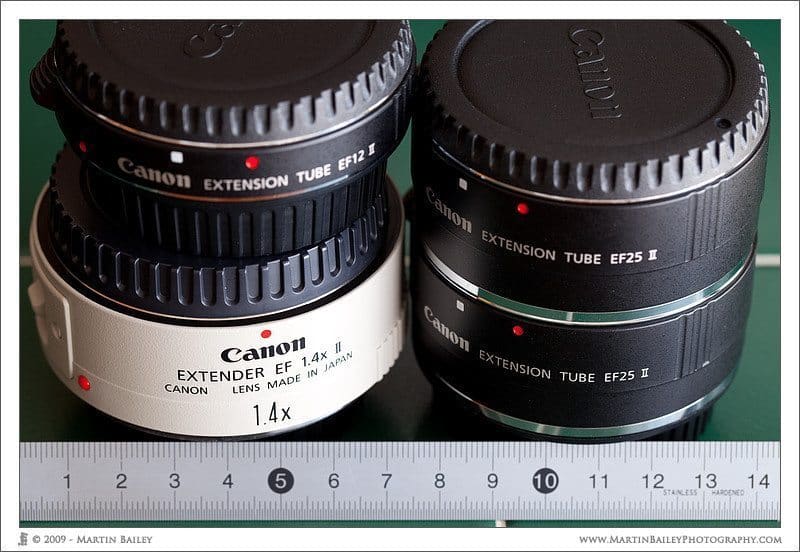

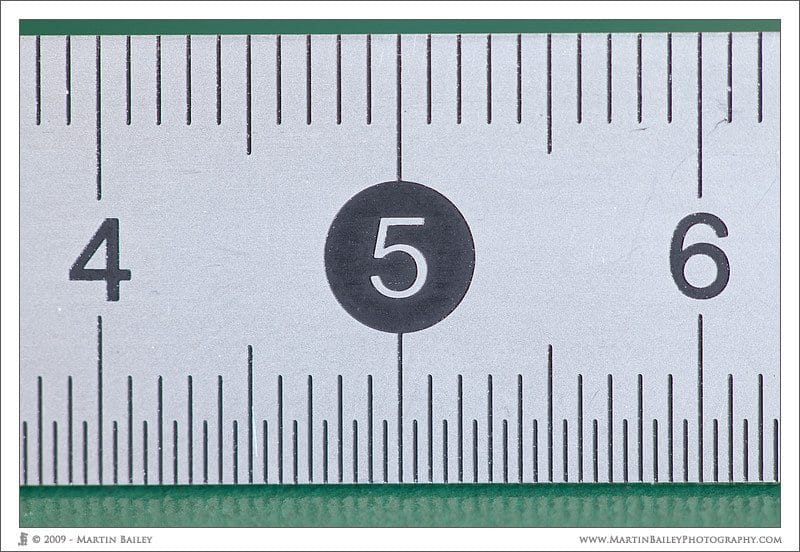
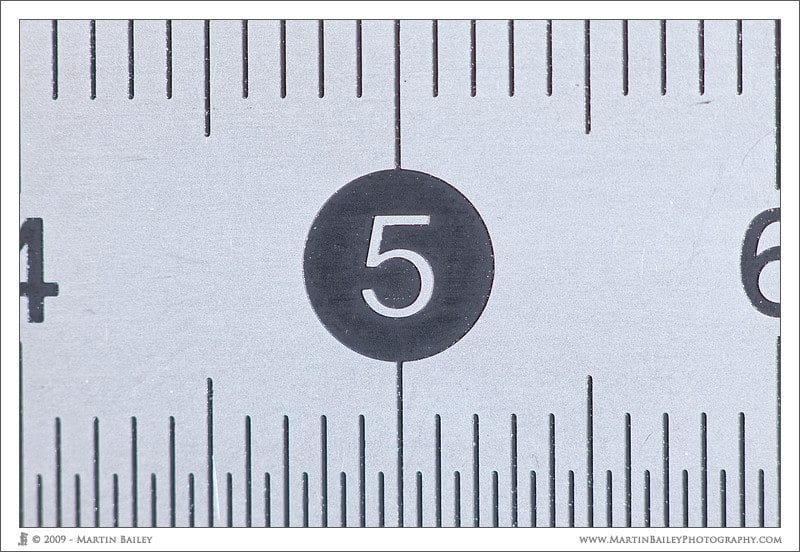
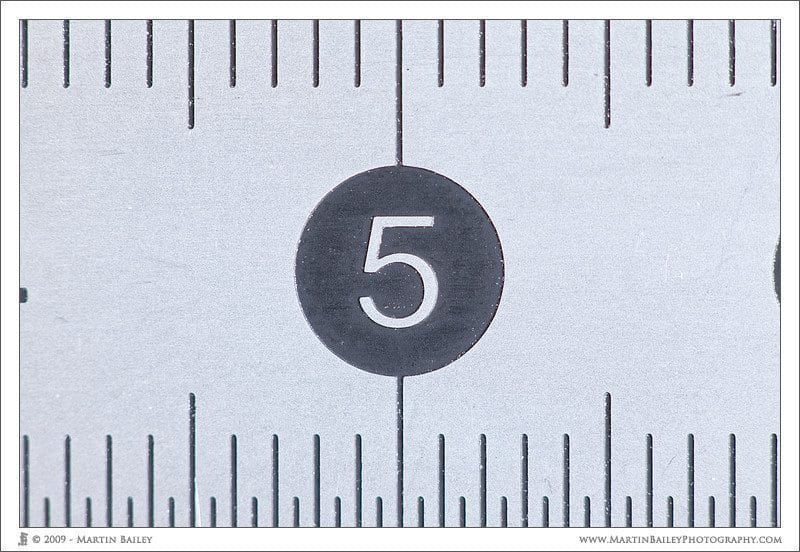
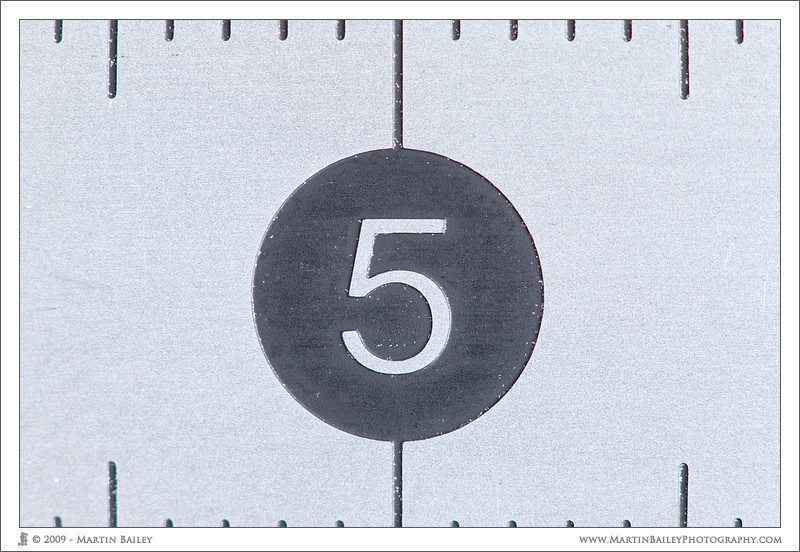

Very cool topic! One (possibly silly) question – if you change around the order of the extender does that change anything?
Martin,
Thanks for the post on using the new 100mm L macro with extenders. One question I did have is that in the owner’s manual is states that the EF 1.4x II/EF2X extenders cannot be used with this lens. When I first read this I was a bit disappointed, but evidently it worked for you, so I wonder why the warning in the manual?
Cheers,
Steve
Andrew, you can have the extension tubes in any order, and it won’t change anything.
For the 1.4X Extender though, and this is also in reply to Steve, you have to ensure that you have enough extension tube between the Extender and the lens, to stop the bit that sticks out of the Extender from hitting the back element of the lens.
It’s a good question about whether or not having the Extender at a different position would change anything. I haven’t tried it, but it may have some bearing on the magnification and/or image quality.
All components have electronic terminals, so I imagine there’s nothing to stop you from having say a 25mm tube, the Extender, then another 25mm tube. Bearing in mind though that the Extender is the most sturdy of the extensions, I’d suggest always putting the Extender on the body first, then attaching the tubes after that. Especially as this removes the risk of the Extender hitting the back of the lens.
Cheers,
Martin.
This is great Martin, thanks! I believe you’ve plugged a hole on the internet – I’d been looking and hadn’t seen a good in-depth look at the use of extension tubes (and extenders, for that matter) with the 100mm macro (L or non-L). It’s what prompted me to ask the question in your 100mm f2.8L review. I wasn’t expecting this though – very helpful! 🙂
One thing I forgot to mention was that I’m on a 50D so does this mean I gain 1.6 times magnification as well? I have no problem dealing with crop factors with regards focal lengths but thinking about it in the context of magnification is making my head hurt slightly.
I guess the subject is perceived as being 1.6 times bigger on a 50D’s sensor than on that of a full frame? But this is because of the smaller sensor and not actual increased magnification… Isn’t it..?
Martin,
Just being picky….from your text above
Having just bought a second 25mm extension tube (Canon Extension Tube EF 25 II), to give me 50mm, or 62mm with the 12mm extension tube also fitted……
The EF25 tubes are actually 27mm so your total extension would be 54mm or 66mm with the setup you tested.
Excellent review in all aspects though…..thanks.
Bob
Phil,
Sorry for the late reply. Thanks for the kind words. I’m pleased this helped.
Your 1.6X magnification will effect the image size in the same way when using the tubes. Any effect that you get from them will be magnified.
Bob,
Thanks for the comment, and I stand corrected.
I am aware of this of course, but from a tutors perspective, the fact that this tube is actually 27mm (they’re actually 12.3mm and 27.3mm to be really picky! :-)) is pretty much irrelevant. People will generally think of them as being 12mm and 25mm and that’s fine in my opinion.
Cheers,
Martin.
This is a very good blog write-up, I’ve learned a lot.
I’ve been using a canon 100mm lens with the 1.4 extender and extension tubes for three months now and I can really recommend it. I’ve got down to 5:1 quite happily and easily, finding not much difference with quality or difficulty from 1:1. That did take three complete sets of tubes though! The set up was very long but to be honest, was kind of easy, with a decent flash anyway. Am moving up to the MPE but it’s been a great few months and definitely the cheaper way to 5:1. MPE offers ease of use and no undoing of extension tubes when you want to return to the shallows of 1:1 after the deep of 5:1. I’m just going to add tubes onto the MPE anyway. There’s no stopping me! Thanks for the article…
Thank you for the excellent article. I have a question about 3D subjects as opposed to 2D. Have you done any tests to determine DOF relating to various extensions and the other lens variables?
My initial tests have been with some passive extensions and lenses from my Olympus OM2 I still have from 35 years ago, and an adapter for my Canon which is set to manual. I wanted to play before leaping in and buying modern gear to see if it was worth it to me.
I was shocked with 65 mm of extension and a prime 50 mm f1.8 lens at the shallow DOF (even at f11 and smaller). A sugar ant’s head was only in focus at one small part! Scary as hell! LOL.
I tried to increase the DOF, testing various lenses and f stops but nothing seemed to help, but this could be related to my weird lash up I guess, perhaps the adapter is throwing things off. I was working under brilliant Florida sun too, so no shortage of light!
I had so much fun though, I am going to buy the proper gear so I can use my Canon lenses.
Thanks again for this page, it is very helpful.
Hi Michael,
What you are seeing is just what happens when you photograph things at very close distances. The closer things get, the shallower the depth-of-field. Extenders/Teleconverters allow you to increase your focal length while maintaining the minimal focus distance, and Extension Tubes allow you to get physically closer to your subject so the depth-of-field will get much, much shallower. Use any online DoF Calculator and punch in the details to check this. One problem you may have though is finding out exact how much magnification your tubes are giving you. This isn’t as easy a calculation as Extenders/Teleconverters, and I don’t have time right now to check for an online tool for you to calculate this.
Cheers,
Martin.
A most excellent article Martin, thank you. I applied this technique using my Canon 60D, the EF-S 50mm macro lens, and my set of ext. tubes which are 65mm total. With the APS-C in the Canon at 22.2mmx14.8mm I rolled the lens alone to the far position (just past the 1:1 mark. I was at 1.06:1 not bad. Once I put the ext tubes on, it jumped to 2.54:1. Of course give or take a little for human error.
Thanks so much for posting this and also for your replies to the comments. I had no idea I could use my extender with the 100mm f/2.8 macro… wish I had read your post before I went out with the macro and extension tubes this morning!
Thanks for this enlightening post. My question has more to do with how far you can get from your subject. I have the 100mm L Macro and am considering the 180mm Macro for its ability to give 1:1 shots farther away from the subject–not spooking insects, more room for lighting, etc.. The 100mm is IS, so easy to use handheld, while the 180mm would work better on a tripod. So I’m considering using a 12mm extension tube and a 1.4X teleconverter on the 100mm lens. How will this affect the focusing distance for 1:1 magnification? Thanks.
Hi Bill,
The 100mm Macro lens gives a 1:1 image when focussed as nearest focus distance, and with the subject at that distance. With a 12mm extension tube, you will get a 1.17x magnification at the closest focus distance, so you could move a little way from the subject and still get a 1:1 image. If you add the 1.4X Extender, you will of course magnify the image, so you’d essentially be getting a 1.5X larger image, or maintain more distance for a 1:1 image.
Extenders do not modify the focussing distance, so your range would be 302mm to 1036mm because of the EF 12 II extension tube, according to the Canon manual for the 100mm f/2.8 IS L lens.
Before writing this, I did test to ensure that my understanding is correct, and indeed, the focusing distances did not change with the Extender fitted.
I hope this helps.
Regards,
Martin.
Hi Martin,
This is an excellant post and one that people can create and do for themselves, I have read countless posts regarding the math behind extension tubes and TBH it just baffled me, this way is so simple and straight forward I shall be doing this same test with my 500 to see how that works out. I will post the results on my blog https://layzeephotography.blogspot.co.uk/
Hi Paul,
I’m pleased you found this useful. Thanks for taking the time to let me know.
Regards,
Martin.
Hi Martin
Should you use AF or not when using an extender?
Thanks for your great articles.
Regards
Hugh
Hi Hugh,
If the resulting aperture is still wide enough that your camera can perform autofocus, then yes.
I sometimes end up with so much Extension that I can’t autofocus, and I will then use manual focus for stationary subjects. If the subject is moving, I’d be more likely to use less Extension and maintain at least the center focus point.
You’re very welcome, for the articles. Thanks for stopping by and commenting.
Regards,
Martin.